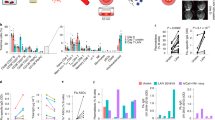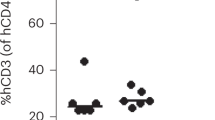Abstract
IT is well established that the thymus plays an important part in the neonatal development of the immune mechanisms. Thymectomy during early life inhibits the rejection of homografts made later1,2. Similarly, animals thymectomized during early life show a decreased ability to produce circulating antibodies, while thymectomy during adult life has no apparent effect on the production of circulating antibodies3–6. Rabbits thymectomized within five days after birth showed either the absence of or greatly reduced response to injections of bovine serum albumin (BSA)7. Although the thymus appears to exert its influence primarily during the neonatal period, it also can function during adult life in that thymectomy pro longs the recovery of immunological capacity following X-radiation8–11. Furthermore, Claman and Talmage12 have shown that adult mice made tolerant by neonatal injection of bovine γ-globulin do not spontaneously lose their tolerant state so rapidly if the thymus is removed. They interpreted their data as supporting the hypothesis that immunological tolerance occurs through irreversible inhibition or death of competent cells and that the loss of tolerance occurs through the development of newly arisen (uninhibited) cells which may originate in the thymus.
This is a preview of subscription content, access via your institution
Access options
Subscribe to this journal
Receive 51 print issues and online access
$199.00 per year
only $3.90 per issue
Buy this article
- Purchase on Springer Link
- Instant access to full article PDF
Prices may be subject to local taxes which are calculated during checkout
Similar content being viewed by others
References
Miller, J. F. A. P., Lancet, ii, 478 (1961).
Martinez, C., Kersey, J., Papermaster, B. W., and Good, R. A., Proc. Soc. Exp. Biol. and Med., 109, 193 (1962).
Fichtelius, K. E., Laurell, G., and Philipson, L., Acta Path. et Microbiol. Scand., 51, 81 (1961).
Archer, O., and Pierce, J. C., Fed. Proc., 20, 26 (1961).
Papermaster, B. W., Dalmasso, A. P., Martinez, C., and Good, R. A., Proc. Soc. Exp. Biol. and Med., 111, 41 (1962).
Jankovic, B. D., Waksman, B. H., and Arnason, B. G., J. Exp. Med., 116, 159 (1963).
Archer, O. K., Pierce, J. C., Papermaster, B. W., and Good, R. A., Nature, 195, 191 (1962).
Miller, J. F. A. P., Nature, 195, 1318 (1962).
Globerson, A., Fiore-Donati, L., and Feldman, M., Exp. Cell Res., 28, 455 (1962).
Miller, J. F. A. P., Doak, S. M. A., and Cross, A. M., Proc. Soc. Exp. Biol. and Med., 112, 785 (1963).
Auerbach, R., Science, 139, 1061 (1963).
Claman, H. N., and Talmage, D. W., Science, 141, 1193 (1963).
Weigle, W. O., J. Exp. Med., 114, 111 (1961).
Weigle, W. O., J. Exp. Med., 116, 913 (1962).
Talmage, D. W., and Maurer, P. H., J. Infect. Dis., 92, 288 (1953).
Farr, R. S., J. Infect. Dis., 103, 239 (1958).
Author information
Authors and Affiliations
Rights and permissions
About this article
Cite this article
WEIGLE, W. Effect of Thymectomy on the Termination of Immunological Tolerance in Rabbits. Nature 201, 632–633 (1964). https://doi.org/10.1038/201632a0
Issue Date:
DOI: https://doi.org/10.1038/201632a0
This article is cited by
-
Immunologische Toleranz
Klinische Wochenschrift (1971)
-
Untersuchungen über die immunbiologische Bedeutung löslicher Leberproteine
Zeitschrift für Die Gesamte Experimentelle Medizin einschließlich experimentelle Chirurgie (1968)
-
Thymus and X-radiation in the Termination of Acquired Immunological Tolerance in the Adult Mouse
Nature (1964)
Comments
By submitting a comment you agree to abide by our Terms and Community Guidelines. If you find something abusive or that does not comply with our terms or guidelines please flag it as inappropriate.



